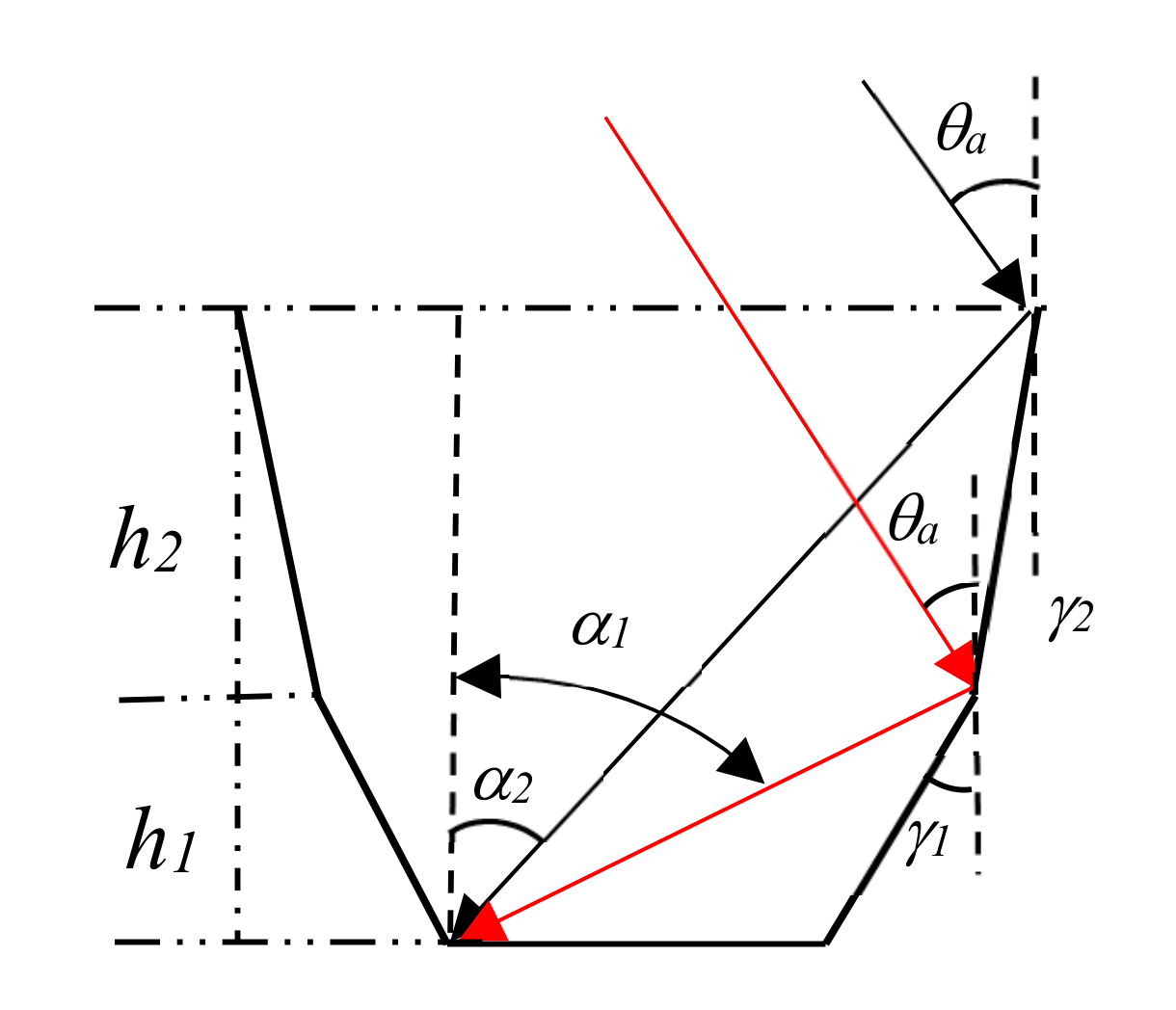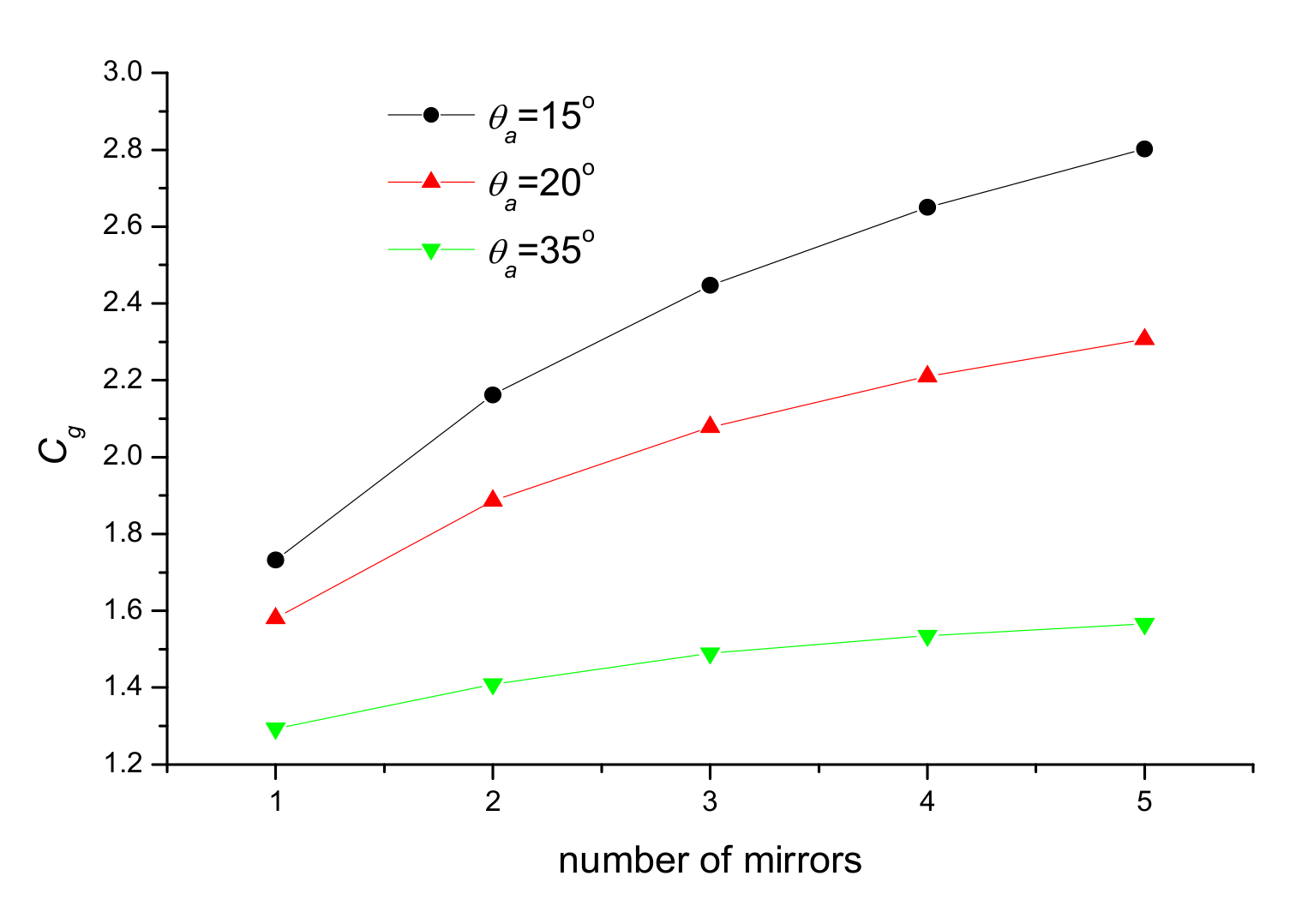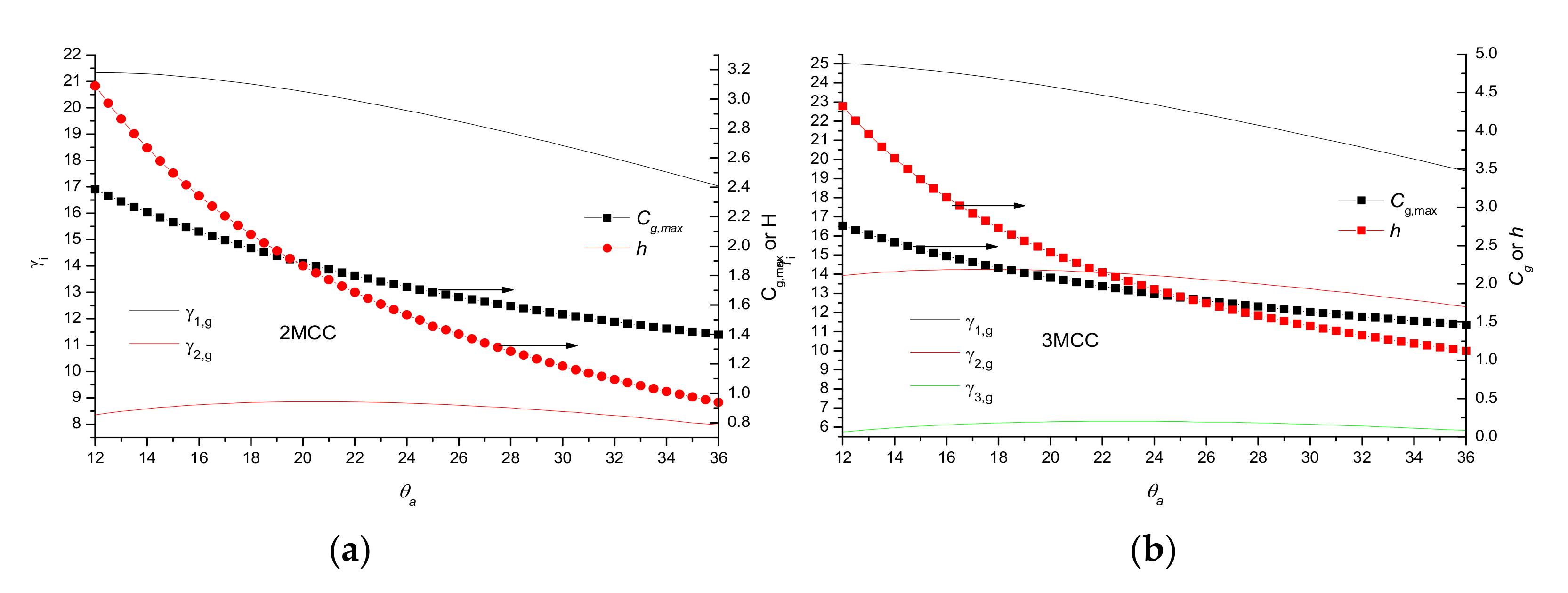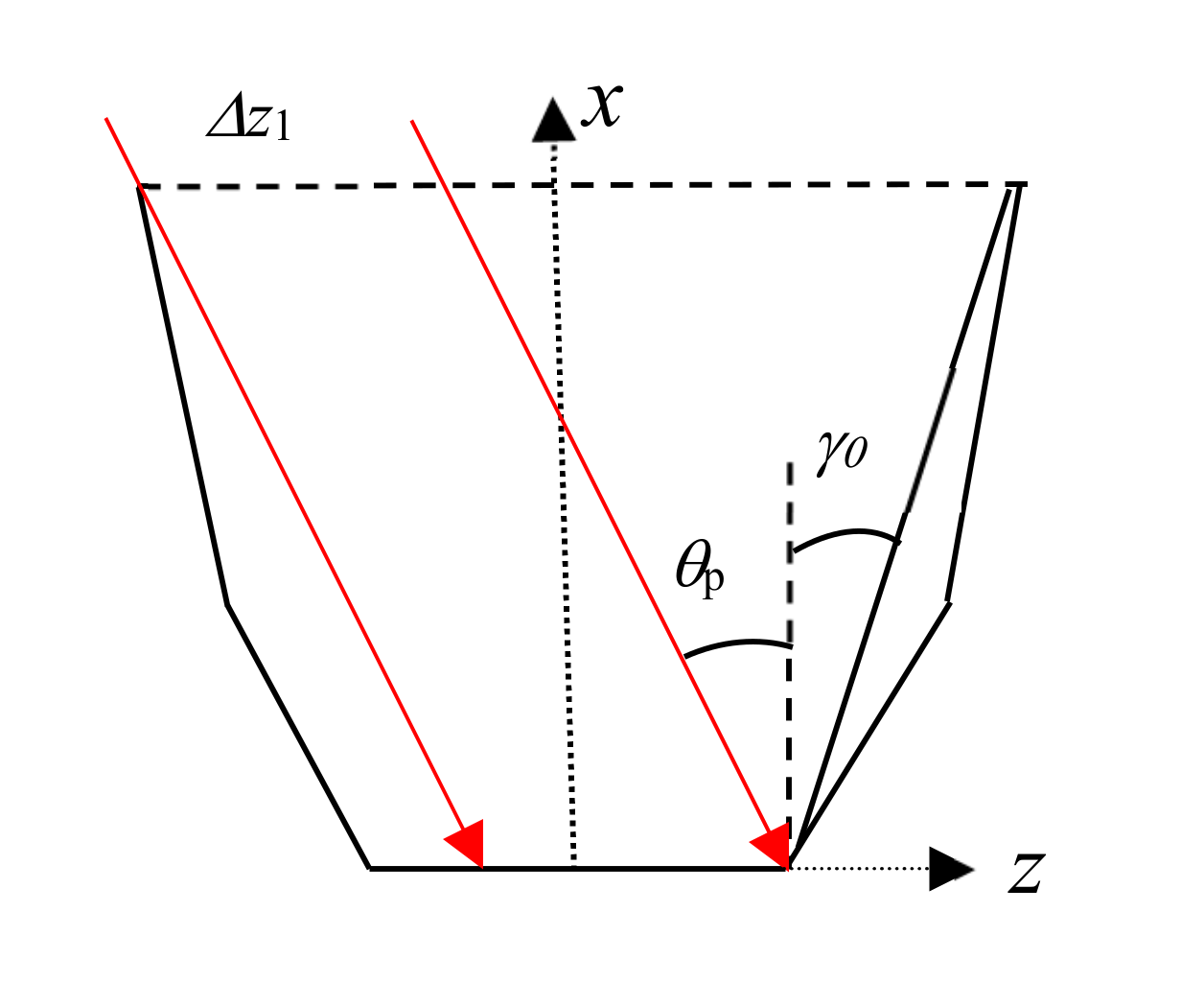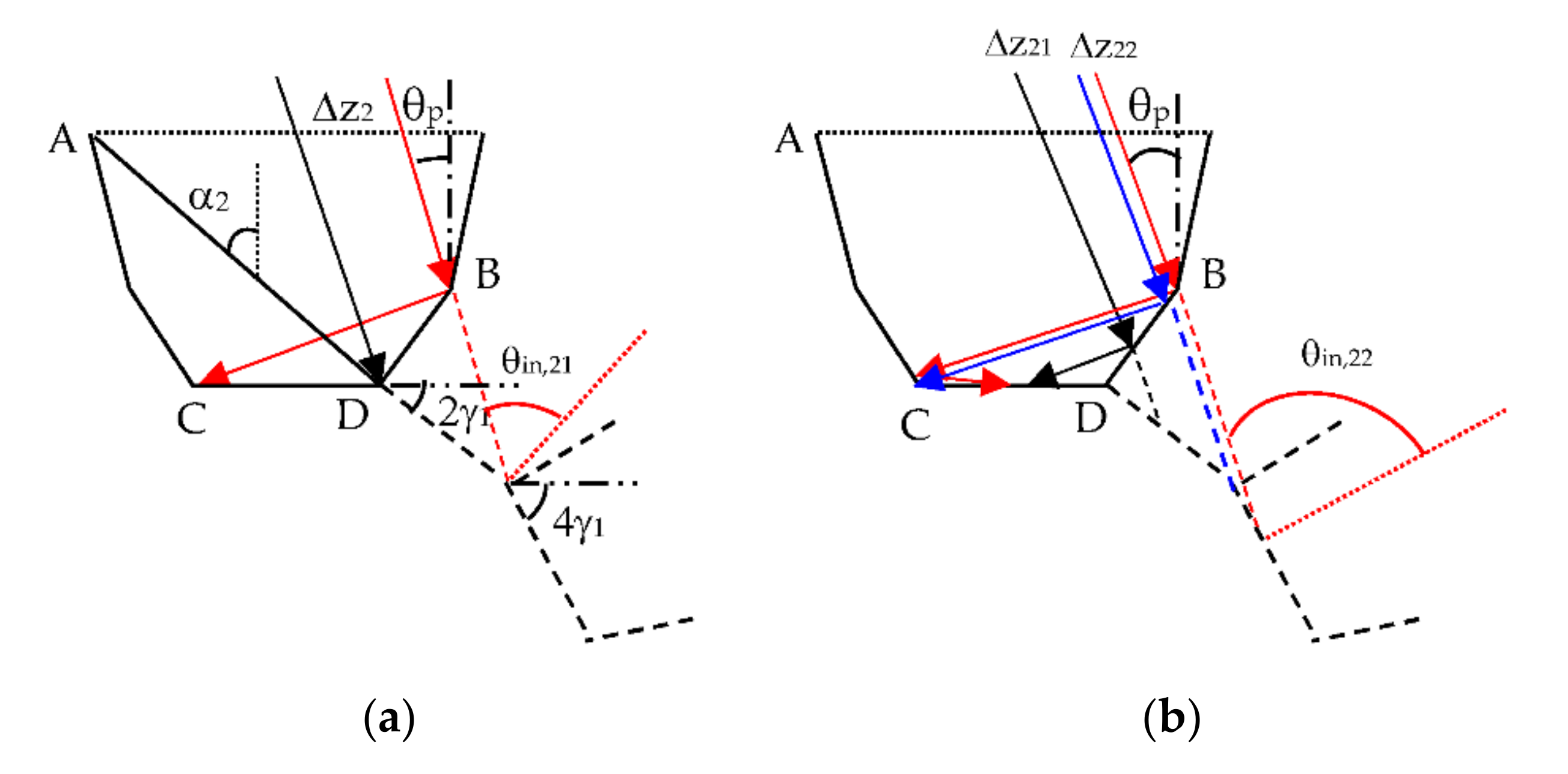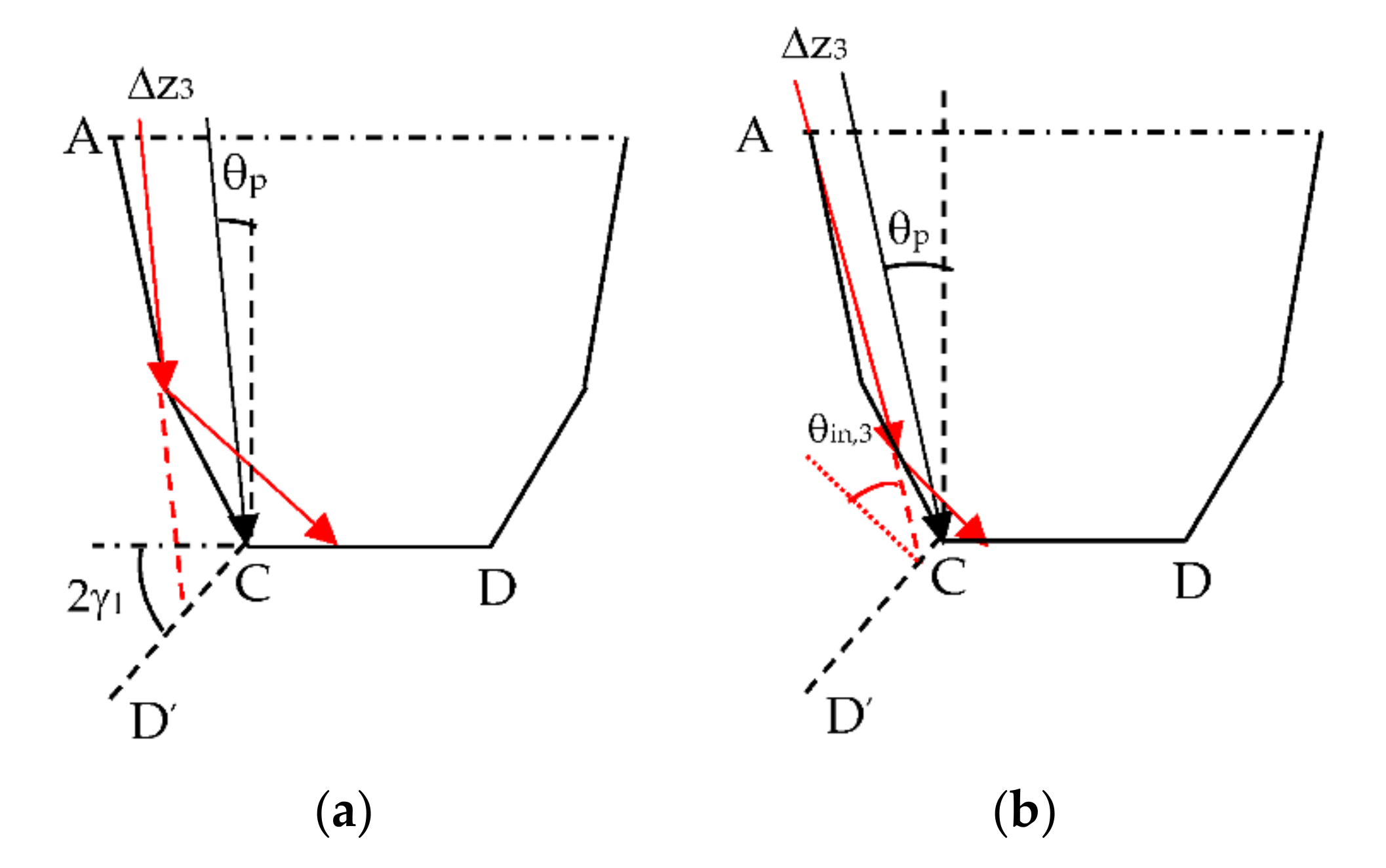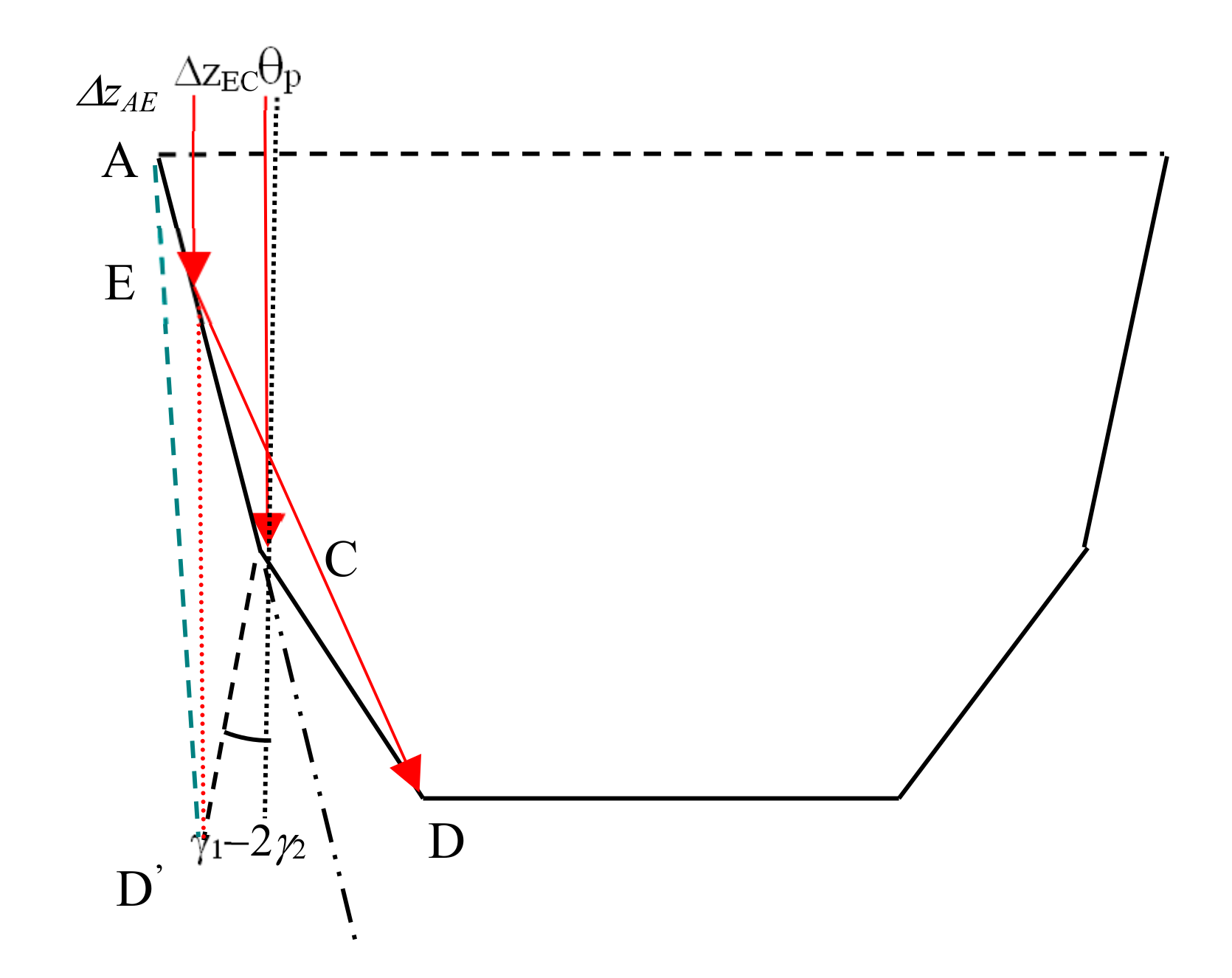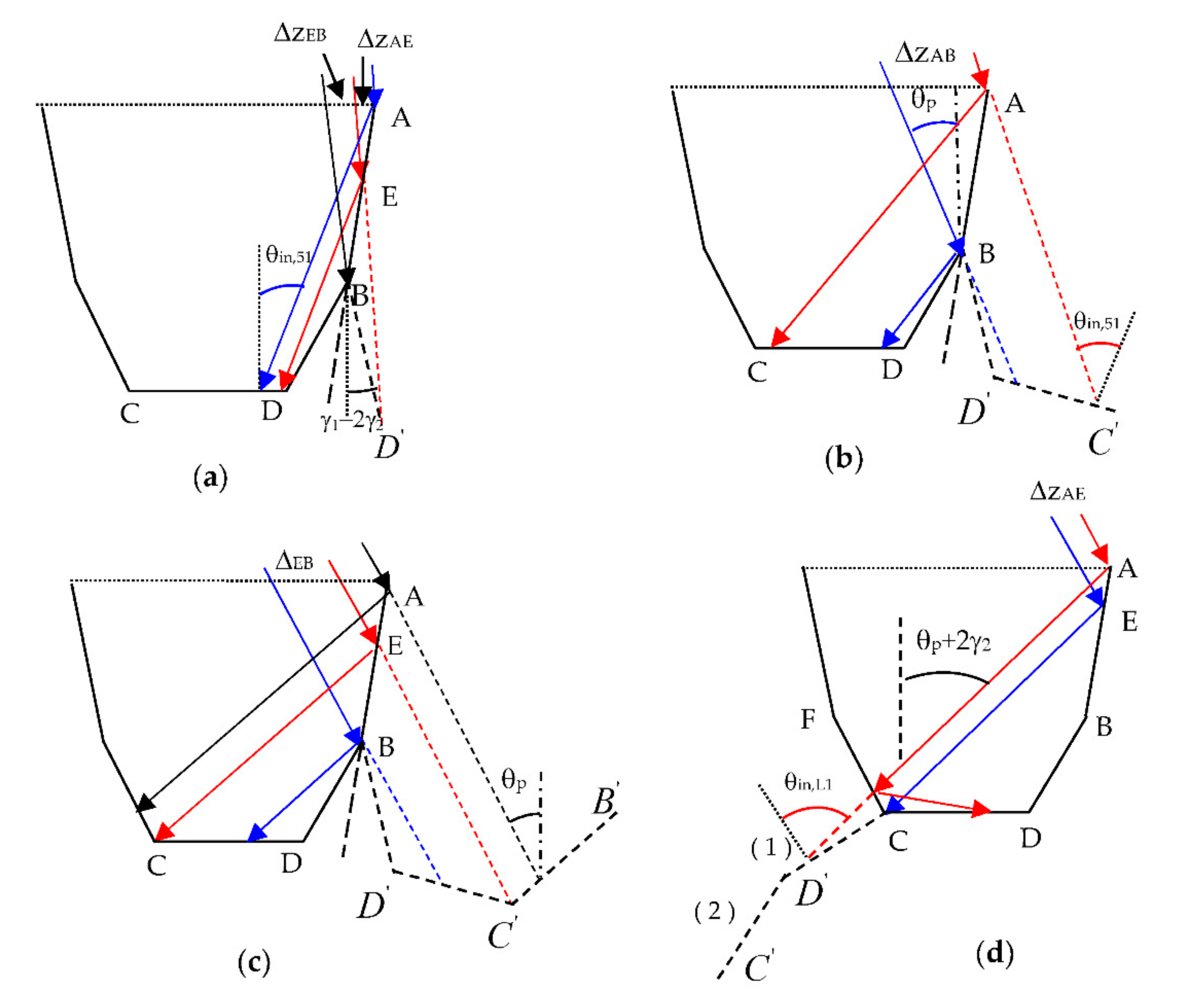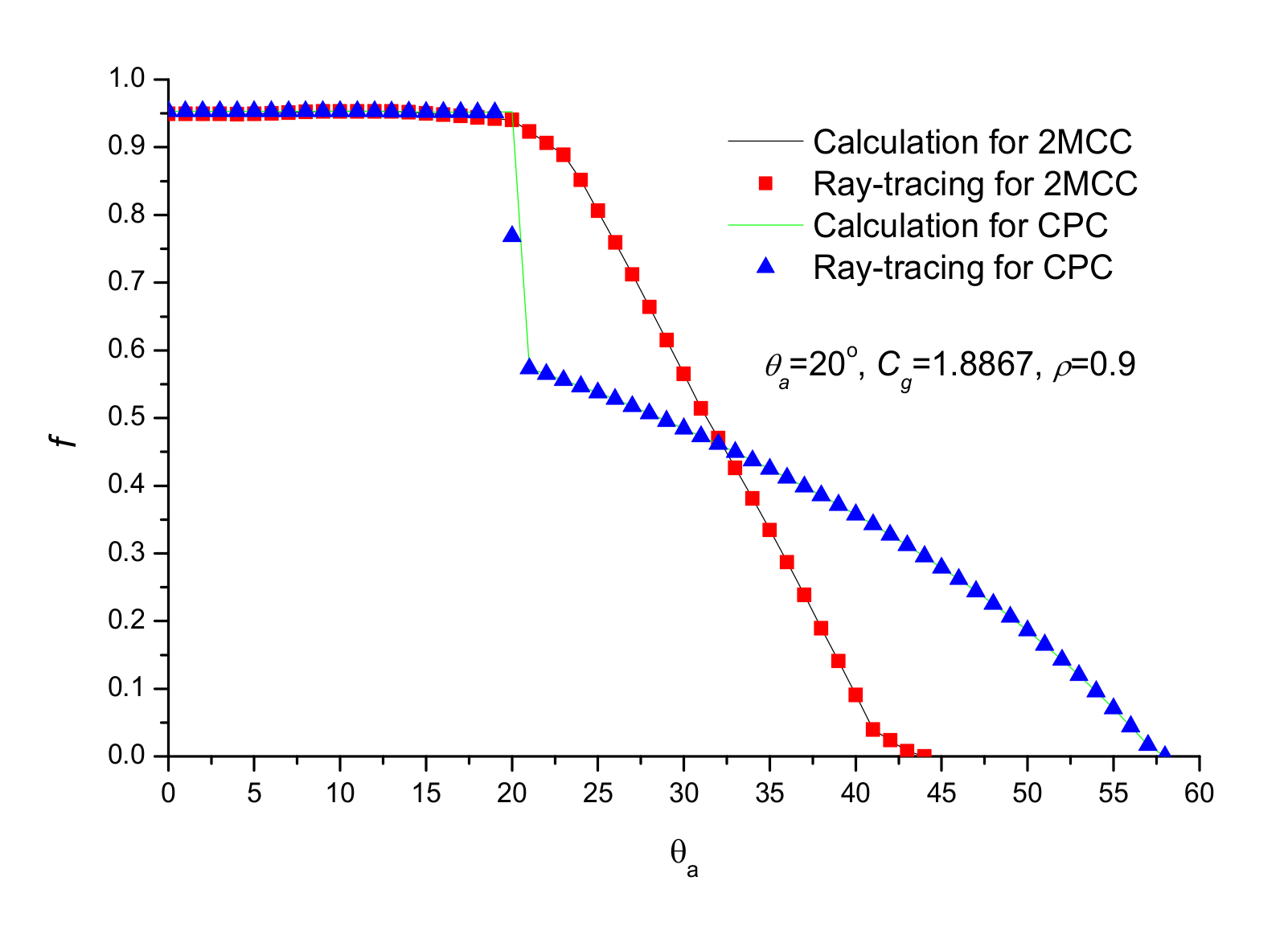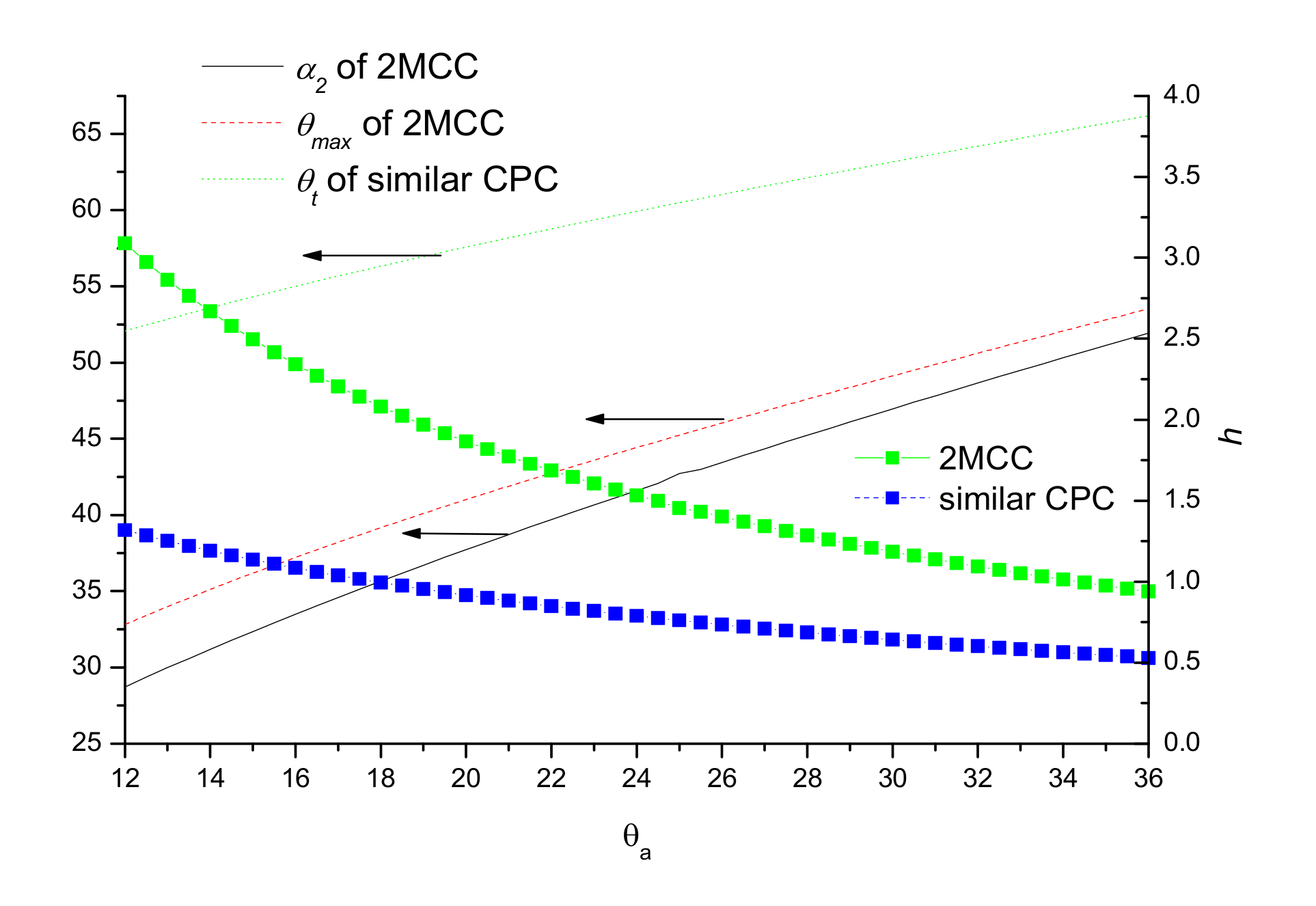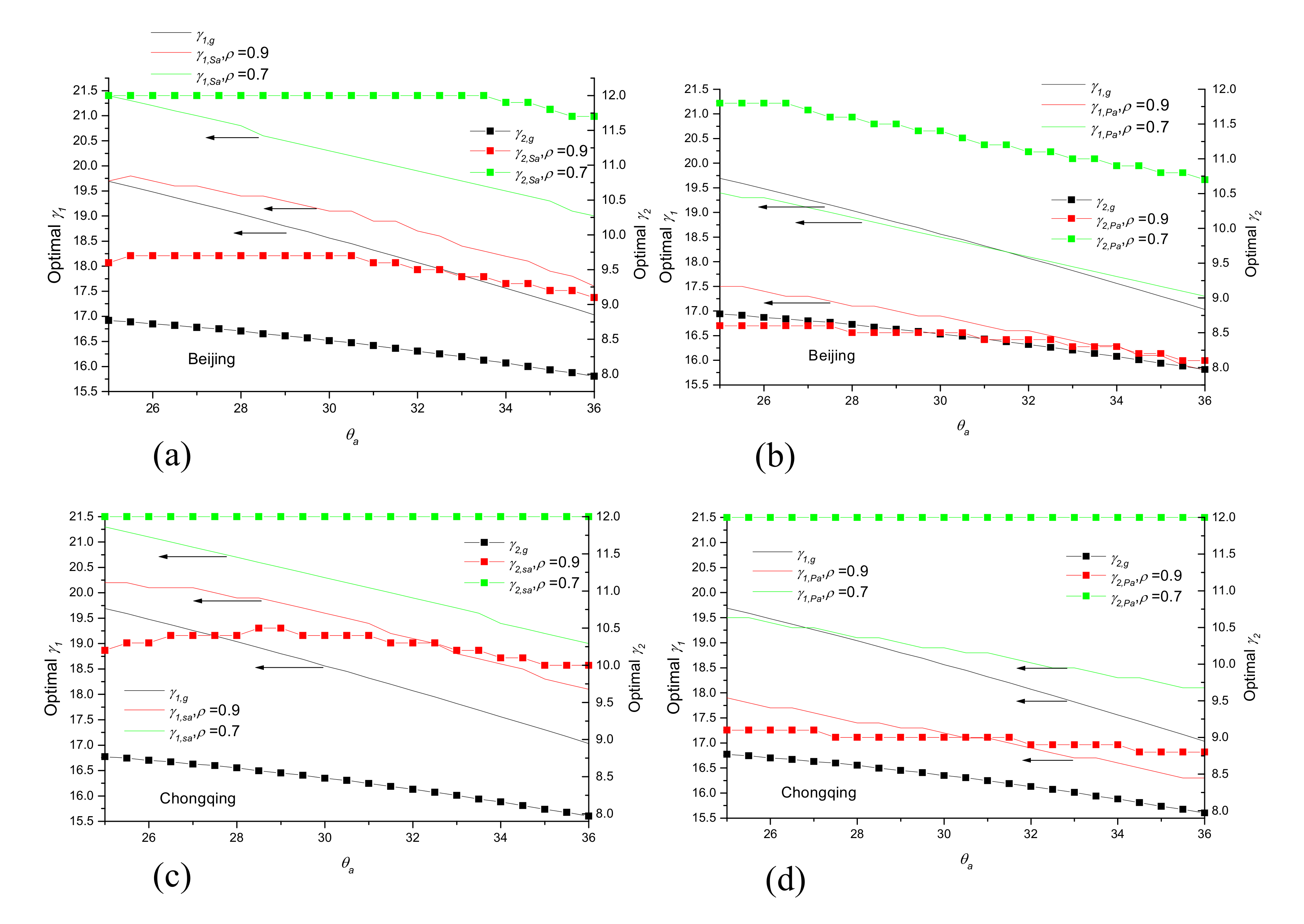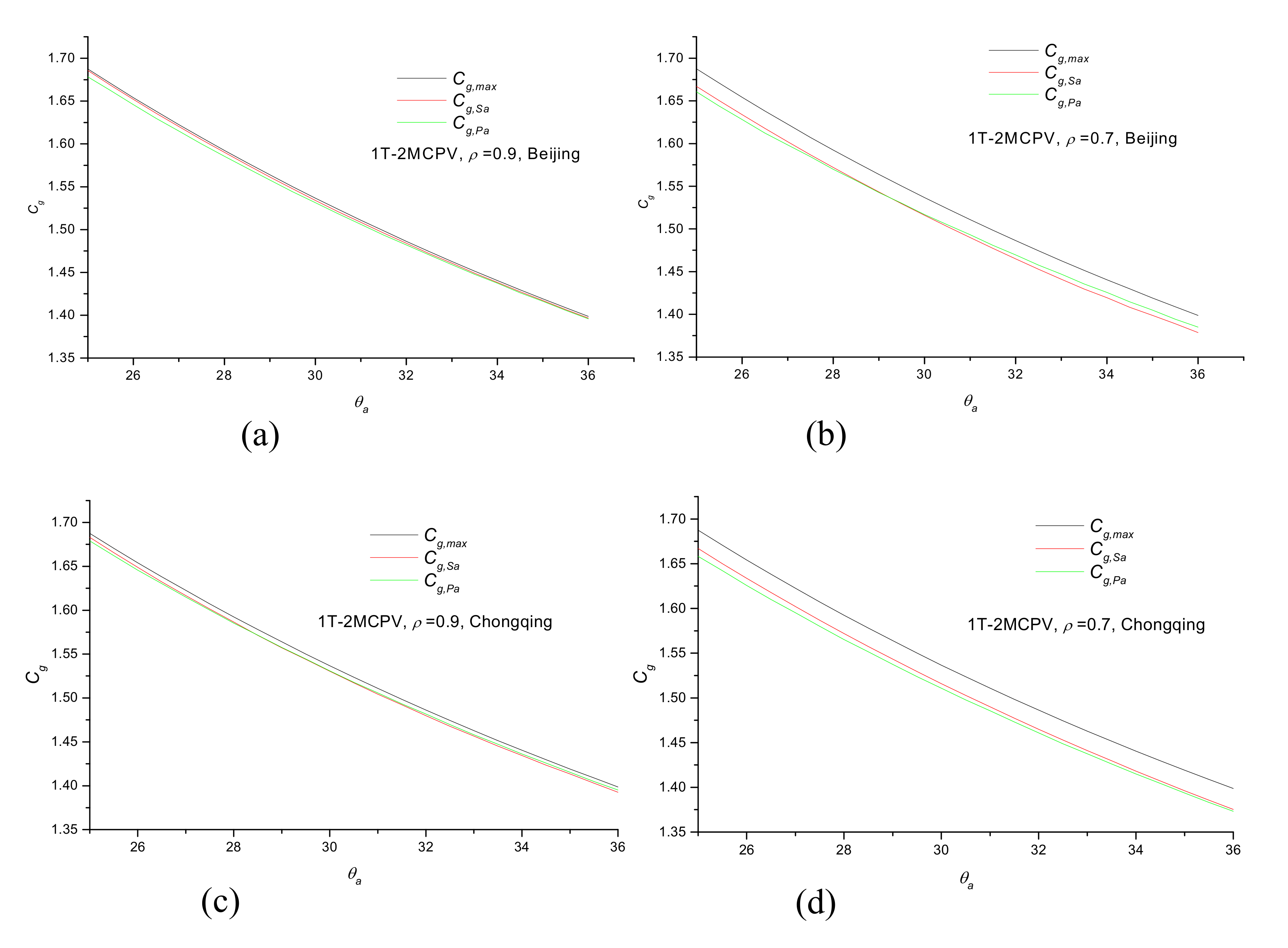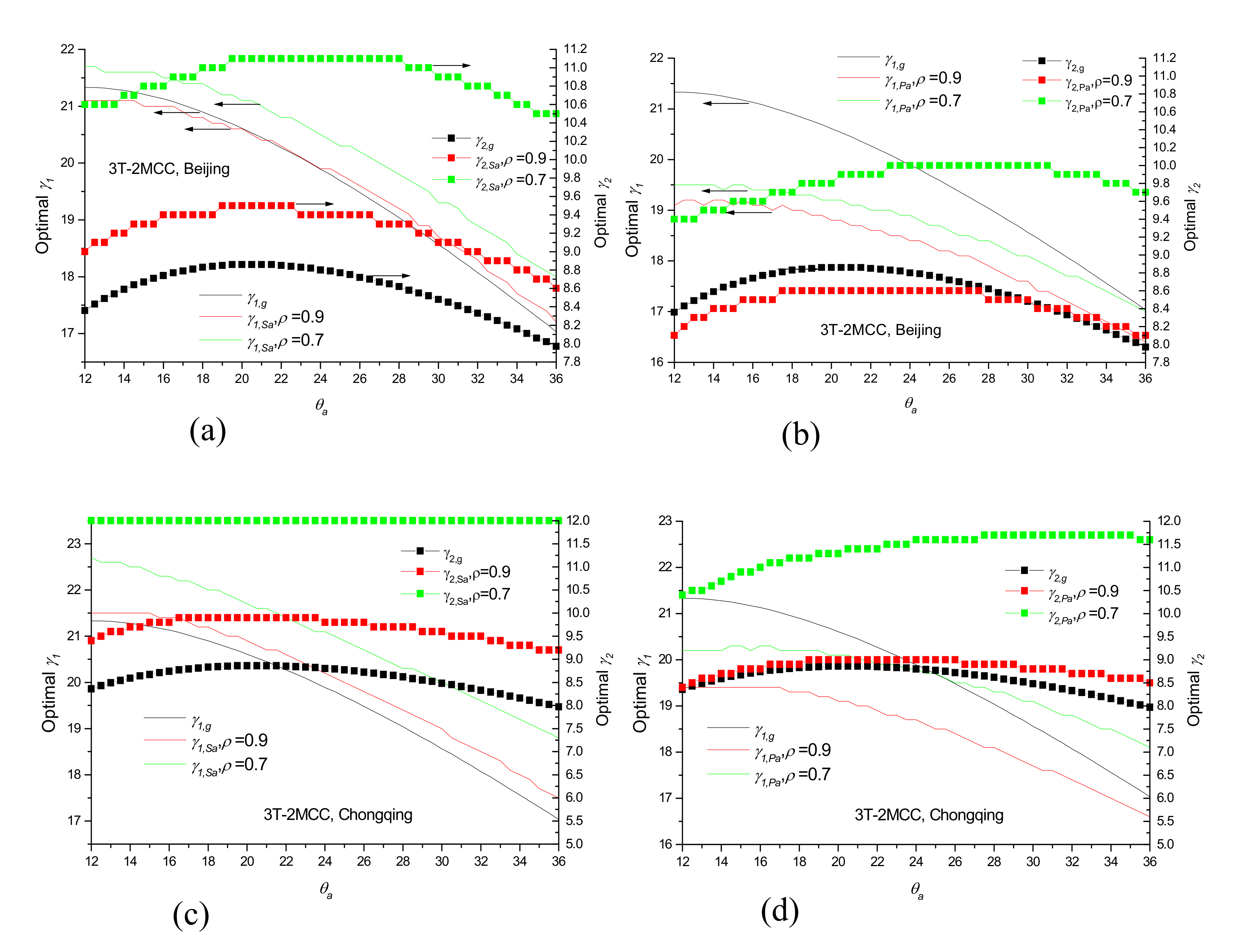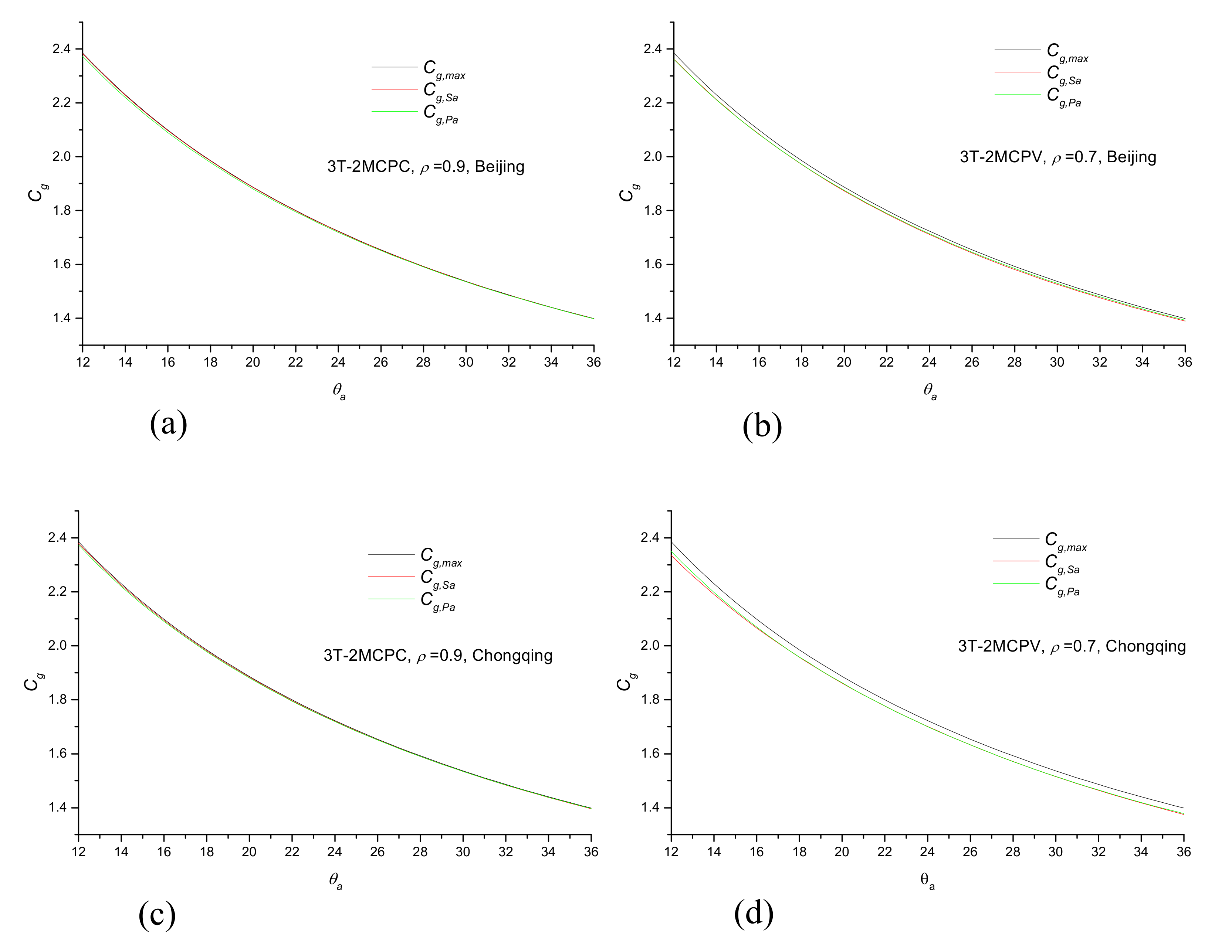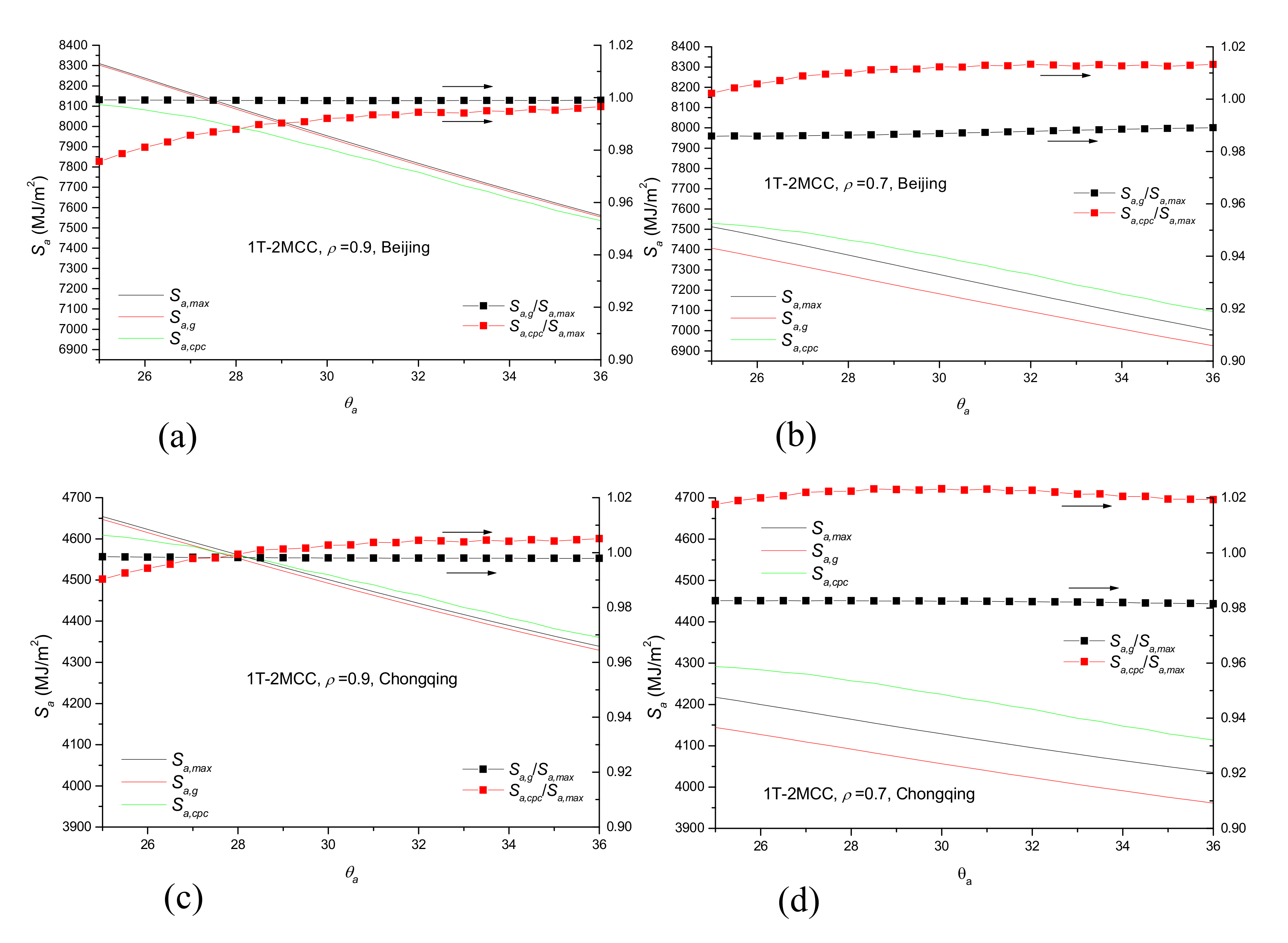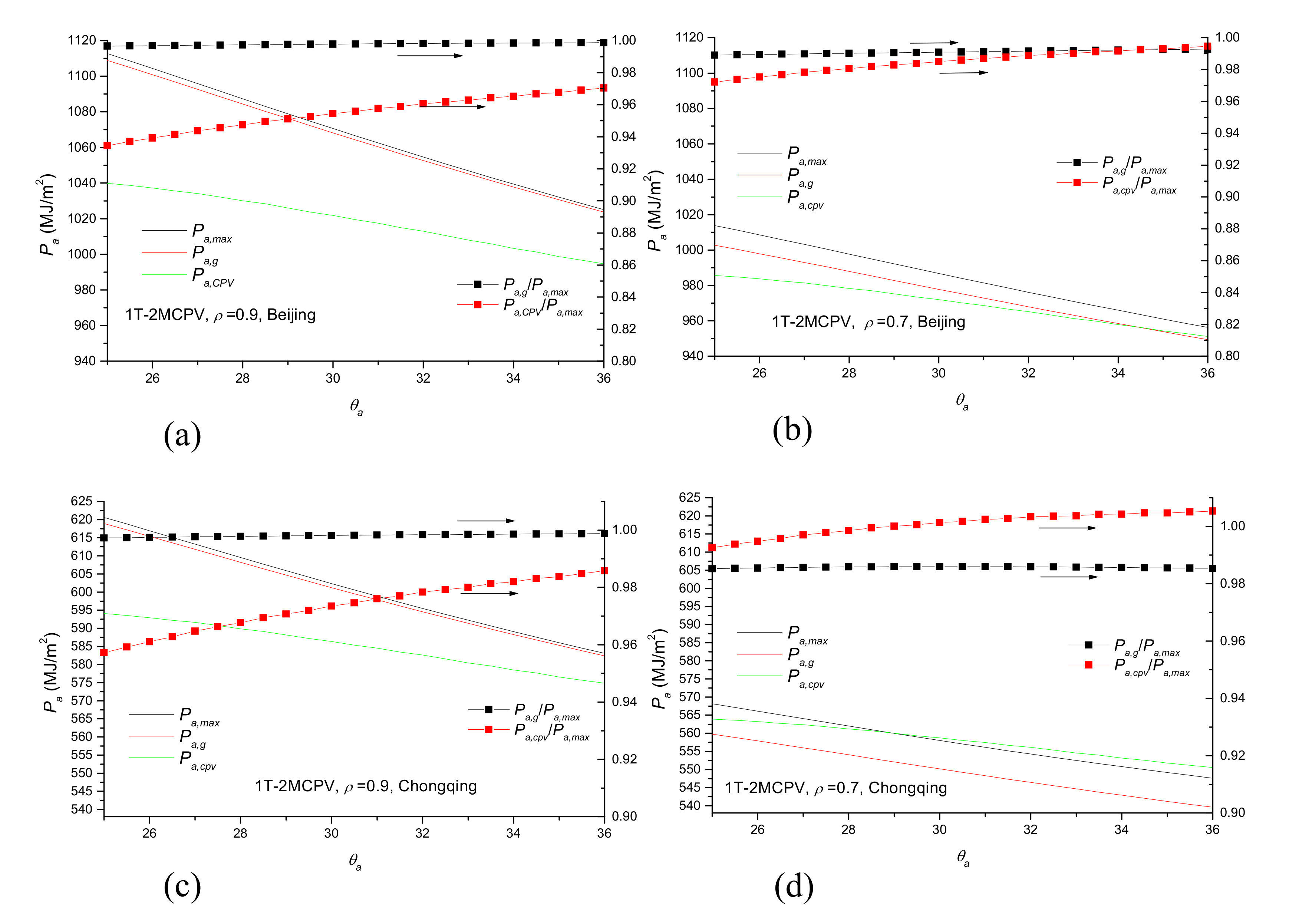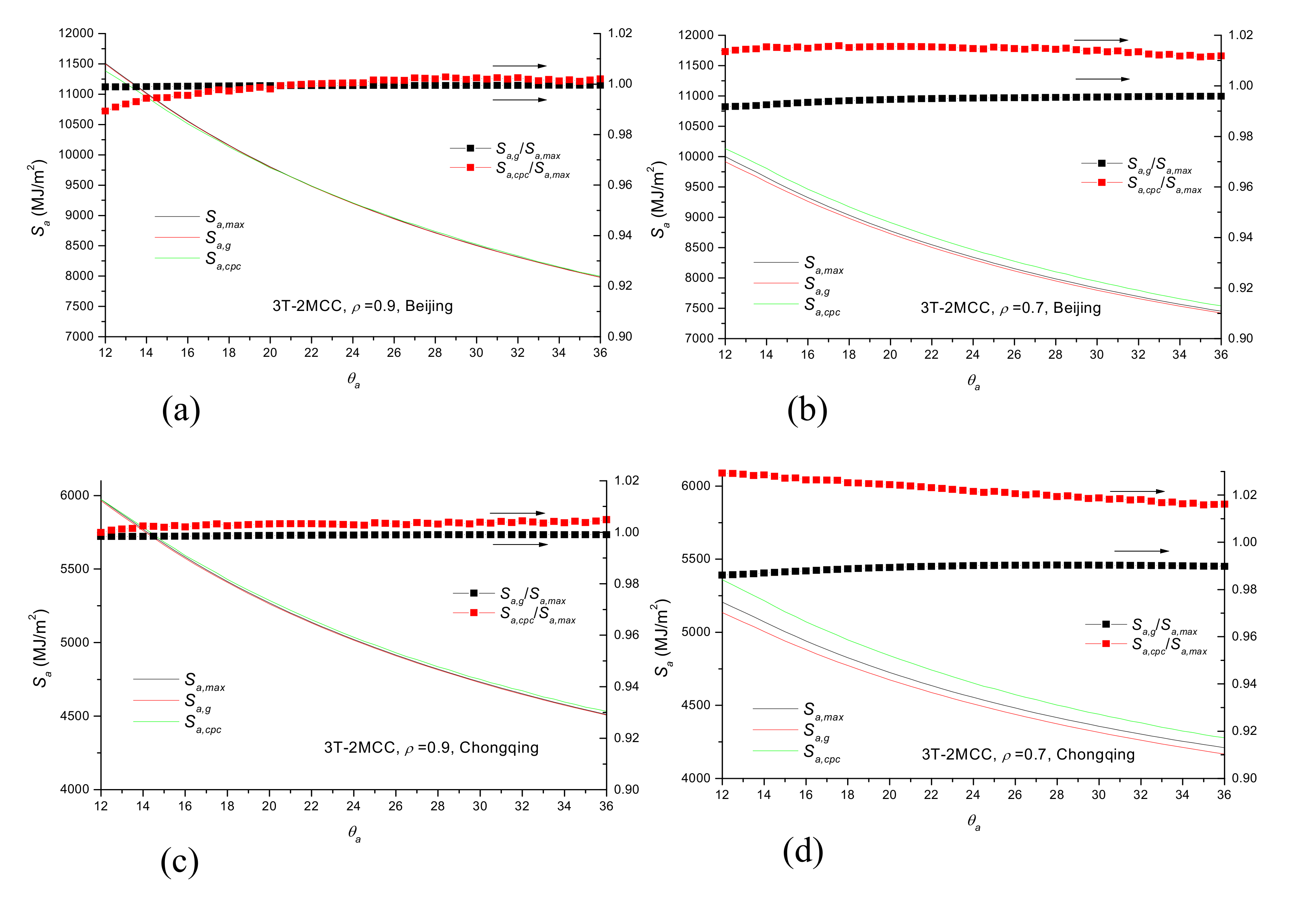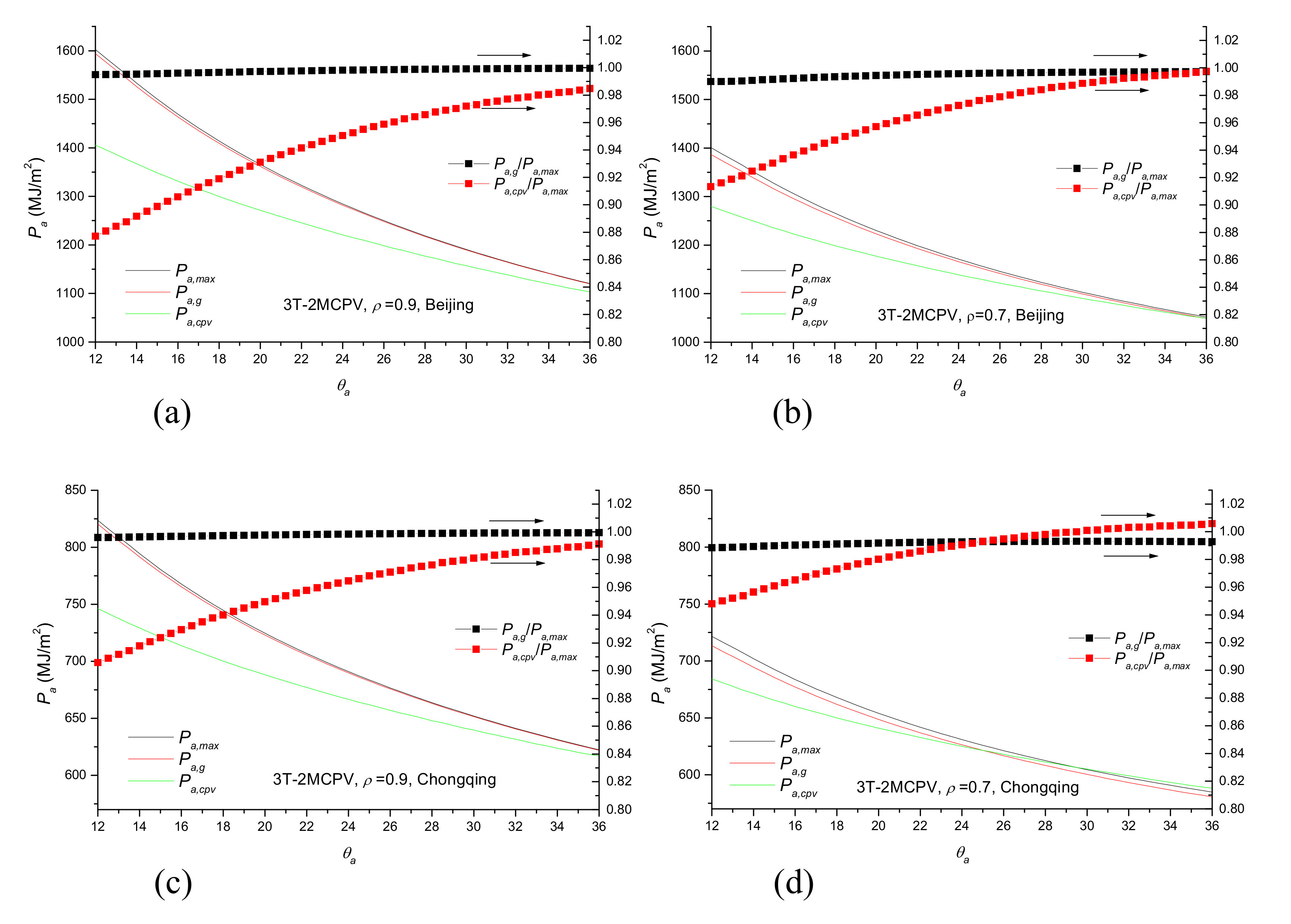1. Introduction
In recent decades, the energy consumption over the world has increased continuously due to the increase in standard of living and comfort level of peoples, which led to the increase of emission of carbon dioxide and environmental issues. The use of renewable energy resources, such as solar, wind, biomass, and geothermal can minimize the utilization of fossils fuels and environmental issues. Among all renewable sources, solar energy has gained tremendous interest due to their abundant availability in most parts of the world and because they are free from pollution [
1,
2]. However, compared to conventional techniques for electricity generation, the cost of the electricity from a PV system is higher and this limits its application [
3]. Apart from further finding cheap materials and advance techniques for the production of solar cells, sun-tracking, and radiation concentrating techniques are widely used to reduce the cost of electricity generated by PV systems. Sun-tracking increases electricity generation from PV panels by maximizing radiation collection [
4,
5,
6], but sophisticated devices in sun-tracking and control are required. In recent years, compound parabolic concentrators (CPCs) and V-trough concentrators were widely tested for increasing the electricity from solar cells. Compared to non-concentrating PV systems, a low concentrating PV system can reduce the cost of electricity by up to 40% [
7]. Tests by Mallick et al. showed that the use of an asymmetric CPC (2.01×) increased the maximum power point of solar cells by 62% [
8,
9]. The experimental study by Brogren et al. indicated that the use of a CPC (3×) increased the maximum power output of solar cells by 90% [
10]. A comparative study by Yousef et al. showed that, compared to similar solar panels, the electricity from a CPC (2.4×)-based PV system (CPV) was 52% and 33% higher, with and without cooling of solar cells, respectively [
11]. These research studies showed that the use of CPCs can increase electricity generation of solar cells but the increments were much less than the geometric concentration ratio (
Cg) of CPCs, a result mainly caused by the optical loss of CPCs due to multi-reflections of solar rays on the way to solar cells [
12,
13]. To simplify the fabrication of CPCs and make solar flux on solar cells more uniform, Tang proposed a concentrator (CPC-A) as the alternative to CPC where the parabolic reflectors are replaced with multi-mirrors [
14].
Compared to CPCs, V-trough concentrators are easier in fabrication, and solar flux on the base is more uniform. Measurements by Sangani and Solanki indicated that the use of a V-trough concentrator (2×) increased the electricity generation of solar cells by 44% [
15,
16]. Theoretical and experimental studies showed that a properly designed V-trough PV system (VPV) was particularly suitable for water pumping [
17,
18]. A study by Vilela et al. showed that, the single axis sun-tracking VPV (2.2×) increased the ACR by a factor of 1.74 but increased the pumped water by a factor of 2.49, as compared to similar fixed solar panels [
19]. Recent work of the authors showed that, as compared to fixed PV panels, the increase of AEG from inclined north–south axis multi-position sun-tracking VPV is even larger than the
Cg [
20]. However, V-trough is not an ideal solar concentrator, the
Cg is restricted, and the optical efficiency is low [
20,
21,
22]. To reduce the optical loss due to reflections, the reflection number of solar rays within V-trough should be restricted, but the
Cg of such V-tough is restricted [
20]. To increase the
Cg of V-trough concentrators, Mannan and Bannerot proposed a two-mirror composite concentrator (2MCC) [
23], but its optical performance was not investigated in this work. As an alternative to CPC, composite multi-mirror concentrators (
n-MCC) was designed by Mullick et al. [
24] based on the edge-ray principle. It is found that the maximum
Cg of
n-MCC increases with an increase of mirror number (
n) and approaches to that of CPC as
n is close to infinite. However, with an increase of
n, the optical efficiency decreases, and solar flux on the absorber becomes more uneven [
14].
To investigate the optical performance of a concentrator, the ray-tracing analysis is commonly employed [
25,
26], but it is time-consuming, even impossible when one investigates effects of geometry of a static solar concentrator on the long-term performance [
14]. Similar to CPCs and V-trough concentrator, the optical performance of a linear
n-MCC is uniquely determined by the projected incident angle (PIA, termed as
θp) of solar rays on the cross-section [
12,
27,
28], thus, two-dimensional radiation transfer can reasonably predict the optical performance [
12]. However, the 2-D model cannot reasonably predict photovoltaic performance as the photovoltaic efficiency of solar cells is sensitive to the incident angle (IA) of solar rays on solar cells [
6,
12]. In this work, a 3-D radiation transfer model was developed based on the vector algebra and imaging principle of mirrors. The objective of this work was to find the optimal design of 2MCC based PV system (2MCPV) for maximizing ACR and AEG and compare its performance with a similar CPC based PV system (CPV), which was identical in
Cg and
θa to 2MCC.
2. Geometric Characteristics of n-MCC
Reflectors of a solar concentrator are commonly designed based on the edge-ray principle, namely, edge rays reflecting from reflectors are required to hit at the ends of a plat absorber or to be tangent to a curved absorber [
29]. As shown in
Figure 1, each of the two reflectors of the linear concentrator investigated here consisted of two plane mirrors, and they were designed in such a way that it made the solar ray incident on the upper end of two mirrors at
θp =
θa arrive on the left end of the flat-plate absorber. Obviously, for such solar concentrator (2MCC), all radiation irradiating on the mirrors at
θp ≤ θa would arrive on the absorber, after less than two reflections. According to the reflection law of light, the geometry of 2MCC should be subjected to (the width of the absorber was set to be 1 for simplifying the analysis):
where
h =
h1 +
h2 is the height of 2MCC,
h1 and
h2 are the vertical height of lower and upper mirrors, respectively, and they are given by:
where the
γ1 and
γ2 are, respectively, the tilt-angle of lower and upper mirrors relative to the normal of absorber (
x-axis), and
α1 =
θa + 2
γ1 and
α2 =
θa + 2
γ2 are, respectively, the incident angle of solar rays on the absorber, after reflection from lower and upper mirrors, when
θp =
θa. Similarly, for the concentrator consisted of n-mirrors (
n-MCC), the geometry was subjected to:
The vertical height (h1) of the bottom mirror is given by Equation (2), and that of the jth mirror counting from the bottom is given by:
It is known from Equations (1)–(3) that, given θa, the geometry of 2MCC is dependent on γ1 and γ2, thus, a set of γ1 and γ2 for maximizing Cg could be found through the iterative calculations. Similarly, Cg of n-MCC was sensitive to the tilt-angle of n-mirrors and a set of γi (i = 1, 2, …, n) for maximizing Cg could be found though multi-loops iterative calculations.
As seen in
Figure 2, given
θa, the
Cg of
n-MCC increased with an increase of mirror numbers (
n), as indicated by Mullick [
24]. The optimal geometry of 2MCC and 3MCC for maximizing
Cg is presented in
Figure 3. It can be seen that the optimal tilt-angle of bottom mirror of
n-MCC for maximizing
Cg (termed as
γ1,g) was highly sensitive to
θa and decreased with an increase of
θa, but that of the top mirror (termed as
γn,g) was weakly sensitive to
θa, furthermore,
γ1,g was always larger than
nγn,g. It was also seen that the maximum
Cg of 2MCC and 3MCC decreased with an increase of
θa. To ensure
Cg > 2, the
θa of 2MCC and 3MCC should be less than 17.7° and 21.3°, respectively. Just like CPCs, linear
n-MCC was commonly oriented in the east–west direction. Therefore, to ensure
Cg > 2 and the sun within
θa of 2MCC and 3MCC for more than 7 h in all days of a year, the tilt-angle of 2MCCs’ aperture should be yearly adjusted four times at three tilts, and that of 3MCC’s aperture should be adjusted more than two times in a year [
27,
30].
3. Mathematical Procedure to Predict the Performance of 2MCPV
The 2MCC orientation was assumed to be in the east–west direction and its aperture to be tilted at
β from the horizon. To make the analysis easier, a coordinate system with the
x-axis normal to the aperture, the
y-axis parallel to the horizon and pointing to the east, and the
z-axis pointing to the northern sky was employed (see
Figure 4). In this coordinate system, the unit vector of the incident solar rays was expressed by [
6,
31]:
where
λ is the site latitude,
ω is the hour angle, and
δ is the declination of the sun, which was determined by the day of the year [
29]. The PIA of solar rays on the cross-section of the linear 2MCC was calculated by:
For the 2MCC symmetric about the normal to aperture, the performance for solar rays
ns = (
nx,
ny, ±
nz) was identical. Therefore, to simplify the analysis, it was assumed that solar rays were always incidental onto the right mirrors (see
Figure 4), namely,
nswas always set to be
3.1. Optical and Photovoltaic Efficiency of 2MCC-Based PV System
The radiation on the absorber of 2MCC include five components—radiation directly incident on the absorber (
I1) and those irradiating first on four mirrors and then arriving on the absorber after reflections (
I2,
I3,
I4,
I5). Therefore, the optical efficiency of 2MCC was expressed by:
where
Iap is the radiation incident on the aperture;
fi (
i = 1, 2, 3, 4, 5) is the energy fraction of the radiation on the absorber contributed by
Ii. Similarly, the PV conversion efficiency of the 2MCC-based PV system (2MCPV) was expressed by:
where
Pi (
i = 1, 2, 3, 4, 5) is the electricity generated by
Ii, and the
ηi (
i = 1, 2, 3, 4, 5) is the PV conversion efficiency of 2MCPV contributed by
Pi.
3.1.1. Radiation Directly Irradiating on the Absorber
As seen from
Figure 4, the absorber was fully irradiated when
θp ≤ γ0 and partially irradiated as
γ0 <
θp <
α2, thus,
f1 =
I1/
Iap = Δ
z1/
Cg was calculated by:
As shown in
Figure 4, the
γ0 could be calculated by:
The electricity from 2MCPV generated by
I1 was given by
P1 =
I1ηpv(
θin,1), thus, the one had:
where
ηpv(
θin,1) is the PV efficiency of solar cells as a function of
θin,1. The IA of the solar rays directly irradiating on the solar cells is given by:
as the unit vector of the normal to solar cells of 2MCPV is
nabs = (1,0,0) in the suggested coordinate system. The electricity from 2MCPV is generally affected by many factors such as cell temperature and electricity load [
32]. To simplify the analysis and facilitate investigating the effects of the geometry of 2MCC on the PV performance of 2MCPV, it was assumed that, except the IA (
θin), effects of the other factors on the PV efficiency of solar cells were not considered, and the PV efficiency of solar cells in percentage was subjected to the correlation, as follows [
33]:
3.1.2. Radiation Irradiating on Right Lower Mirror and Arriving on the Absorber
According to the geometric characteristics of 2MCC and the imaging principle of mirrors, one knows that all radiation irradiating on the right lower mirror arrives on the absorber after one reflection when
θp ≤ θa, whereas for the case of
θp >
θa, a fraction of radiation would arrive after more than one reflection, as seen in
Figure 5 [
22]. For the case of
θp ≤
θa, the radiation incident on right lower mirror and arriving on the absorber after reflection was
I2 =
Δz2ρ, hence, one had:
where
ηpv(
θin,21) is the PV efficiency of solar cells as the function of
θin,21 and is determined by Equation (16). The IA of the solar ray on solar cells in this case (see left of
Figure 5) was given by:
as the unit vector of the normal to first right-image of the absorber formed by lower mirrors is (cos2
γ1,0,sin2
γ1), due to the first right-image making an angle of 2
γ1 from the absorber [
12,
20,
22].
When solar rays are incident on the aperture at
θp >
θa, a fraction of radiation incident on the right lower mirror might arrive on the absorber after more than one reflection, as shown in the right side of
Figure 5. The PIA of solar rays on the absorber after multi-reflections within the V-trough formed by the two lower mirrors was equal to (2
γ1k +
θp) and was required to be less than 90°, thus the maximum reflection number of solar rays within the V-trough was given by:
as multi-reflections take place only when
θp >
θa. Calculations showed that
γ1 of the 2MCC optimized for maximizing the
Cg was larger than 17° for
θa < 40°, thus
kmax was 2. This meant that more than two reflections would not take place for
θa < 40°. In practical applications,
θa should be less than 40° to ensure
Cg > 1.3. Therefore,
f2 and
η2 for the case of
θp >
θa could be calculated by:
where
Δz21 and
Δz22 are the radiation that irradiates on the right lower mirror and arrives on the absorber after one and two reflections, respectively (see
Figure 5). They were calculated by [
20,
22]:
where
FR1 and
FR2 are the
z-coordinate differences between two ends of the right first and second images irradiated by the incident radiation, respectively, and they were given by:
where
The
C1 = 2
h1tan
α1 − 1 was the geometric concentration of 1MCC (V-trough formed by two lower mirrors of 2MCC). The
θin,22 in Equation (22) was the IA of the solar rays after two reflections and was determined by:
as the unit vector of the normal to second right-image was expressed by (cos4
γ1, 0, sin4
γ1). It was noted that
f2 and
η2 were set to be zero when
θp ≥ 90 − 4
γ1 or
θp ≥
θmax. The
θmax was the angle of the edge-ray that irradiated on lower mirrors and arrived on the absorber, after more than one reflection, and was determined by:
where
θ1 and
θ2 are, respectively, the angle of rays passing the left/right-end of the aperture and the right/left-end of first and second right/left images, and was calculated by:
3.1.3. Radiation Irradiating on the Left Lower Mirror and Arriving on the Absorber
First, it should be addressed that all radiation irradiating on the left mirrors would arrive on the absorber after less than two reflections, because
θp was negative, thus, it was less than
θa, as the radiation was always assumed to be incident onto the right mirrors, in this work. As seen in
Figure 6, the left lower mirror was fully irradiated when
θp ≤ γ2, and partially irradiated for
γ2 <
θp <
γ0. Thus one had:
The IA of the solar rays after reflection was given by:
as the unit vector of the normal to the image formed by left lower mirror was (cos2
γ1,0, −sin2
γ1) [
12]. Therefore, the
η3 was given by:
3.1.4. Radiation Irradiating on Left Upper Mirror and Arriving on Solar Cells
As shown in
Figure 7, the CD’ was the image of the lower mirror (CD) formed by the upper mirror (AC). According to the imaging principle of mirrors, one knows that when
θp ≥
, all radiation incident on the upper mirror would redirect onto the lower mirror first and then redirect onto solar cells; whereas for
θp <
, radiation incident on the upper part (AE) of the upper mirror directly redirected onto solar cells and that on the lower part (EC) redirected onto the lower mirror (CD) first, then redirected onto the solar cells. Therefore,
f4 could be calculated by:
where
is the angle of line
relative to the
x-axis and determined by:
as the image
of lower mirror made an angle of
γ1 − 2
γ2 relative to
x-axis. The
in Equation (36) was the width of image
and was given by
=
h1/cos
γ1. The
hEC in Equation (34) was the vertical height of the mirror EC and was calculated by:
The IA of the solar rays directly redirecting onto the solar cells was calculated by:
as the vector of the normal to the image of solar cells formed by left upper mirror was (cos2
γ2,0, −sin2
γ2). The IA of the solar rays redirecting onto the lower mirror (CD) first, then onto the solar cells was calculated by [
12]:
On knowing
θin,41 and
θin,42, one could calculate
η4 as follows:
3.1.5. Radiation Irradiating on the Right Upper Mirror and Arriving on the Absorber
As seen in
Figure 8, the methods through which the solar rays irradiate on the right upper mirror and arrive on the absorber, differed for different
θp and were divided into four cases, as follows.
As shown in
Figure 8a, the image
of the right lower mirror (BD) formed by the right upper mirror made an angle of
γ1 − 2
γ2 from the
x-axis, therefore, when the solar rays were incident on the upper mirror at
θp <
γ1 − 2
γ2, the radiation irradiating on the upper part (AE) of the mirror directly redirected onto the solar cells, and that on the lower part (EB) redirected onto the lower mirror (BD) first, and then onto the solar cells. The
f5 and
η5 in this case were calculated by
The vertical height of EB was given by:
The IA of the solar rays on the solar cells reflecting from AE (
θin,51) and those reflecting from EB (
θin,52) were calculated by [
12]:
In this case, all radiation incident on the right upper mirror directly redirected onto the solar cells, as shown in
Figure 8b, therefore, one had:
As shown in
Figure 8c,d, the angle of line AC relative to the
x-axis was equal to
α2 and the angle of rays reflecting from right upper mirrors was
θp + 2
γ2. Therefore, when
α2 <
θp + 2
γ2 <
θmax, i.e.,
θa <
θp <
θmax − 2
γ2, the radiation incident on the lower part (EB) of the right upper mirror would arrive on the solar cells after one reflection and that on the upper part (AE) would redirect onto the left lower mirror first then onto the absorber, after more than one reflection. Thus, the radiation incident on right upper mirror at
θa <
θp <
θmax − 2
γ2 and arriving on the solar cells included two components—directly redirecting on solar cells (
I5,1) and redirecting to the left lower mirror first, then onto the solar cells (
I5,2). The
I5,1 could be calculated by:
as the IA of the ray reflecting from the lower end (B) of the right upper mirror should be less than
α1, namely
θp + 2
γ2 ≤
θa + 2
γ1 (
θp ≤
θa + 2
γ1 − 2
γ2), thus, no radiation arrived on the solar cells after reflection from the right upper mirror, when
θp >
θa + 2
γ1 − 2
γ2. The electricity generated by
I5,1 was given by:
As shown in
Figure 8d, when
θa <
θp <
θmax − 2
γ2, the rays reflecting from the upper part (AE) of the right upper mirror redirected onto the left lower mirror first and then onto the solar cells, after more than one reflection. The
I5,2 and
P5,2 were calculated by:
where
ΔzL1 and
ΔzL2 were the radiation reflecting from the right upper mirror and arriving on the solar cells after one- and two-reflection, respectively, and were calculated as follows:
where
FL,1 and
FL,2 are the
z-coordinate differences between the two ends of the first and second left-image of the absorber irradiated by the radiation from AB, respectively, and they were given by:
where
The IA of the solar rays from AE and arriving on the solar cells after one- and two-reflection was equal to that of rays from AE on the first and second left-image of solar cells, formed by the lower mirrors, respectively, and they were calculated by [
12]:
as the unit vector of the ray reflecting from AE was given by
rAE = (cos2γ
2, n
y, n
z + 2cosθ
in,AEcosγ
2) and the IA of the solar rays on the AE was given by cos
θin,AE =
ns ·(sin
γ2,0, −cos
γ2) =
nx sin
γ2 −
nz cos
γ2. It was noted that
ΔzL1 = 0 when
θp > 90° − 2
γ1 − 2
γ2 and
ΔzL2 = 0 as
θp > 90° − 4
γ1 − 2
γ2, because the PIA of the solar rays from the AE on the first and second left-images was equal to
θp + 2
γ2 + 2
γ1 and
θp + 2
γ2 + 4
γ1, respectively, and they were required to be less than 90°. On obtaining
I5,1,
P5,1,
I5,2 and
P5,2, one had:
The analysis in above showed that the optical efficiency of 2MCPV only depended on θp, but the PV efficiency depended on θp and nx.
3.2. Annual Optical and Photovoltaic Performance of 2MCPVs
It was assumed that the diffuse radiation from the sky was isotopic and that reflection from the ground was not considered. Therefore, the radiation on the unit area of the solar cells of 2MCPV at any moment of a day could be calculated by:
as the IA of the solar rays on the aperture was given by cos
θap =
ns ·(1,0,0) =
nx. The electricity generated by the unit area of the solar cells of 2MCPVs at any time of a day was calculated by:
where
Ib is the intensity of beam radiation, the
, a control function, is 1 for cos
θap > 0 otherwise zero. The
Iabs,d in Equation (61) is the sky diffuse radiation collected by the unit area of the solar cells and could be calculated on the basis of the two-dimensional sky diffuse radiation, as follows:
as the optical efficiency of the linear 2MCPV was only dependent on
θp, and the directional intensity of the sky diffuse radiation on the cross-section of the east–west oriented 2MCPV was isotropic [
6] for the isotropic sky diffuse radiation and was equal to 0.5
Id [
13].
Pd in Equation (62) was the electricity generated by
Iabs,d and should be calculated on the basis of the three-dimensional sky diffuse radiation, as follows [
12]:
as the PV efficiency of 2MCPV depended on
θp and
nx, and the electricity generated by diffuse radiation from a finite element of the sky dome was d
Pd =
idCgcos
θηsin
θ with
id = π
Id/3 [
12]. The
φ0 in Equation (64) was related to
θ by:
The
Id in Equations (63)–(64) was the sky diffuse radiation on the horizon. For a given 2MCPV,
Cd in Equation (63) and
Cd,pv in Equation (64) depended on
β and could be numerically calculated. The radiation on the unit area of the solar cells of 2MCPV in a day could be estimated by integrating
Iabs over the daytime of the day, as:
The daily electricity from unit area of the solar cells was estimated by:
where the
Hd in Equations (66)–(67) is the daily sky diffuse radiation on the horizon,
t0 is the sunset time on the horizon in a day.
At any time of a day, the position of the sun in terms of ns could be determined, then f and η could be calculated. Therefore, given the time variation of Ib and Hd in a day, Hday, and Pday could be numerically calculated, then summing Hday and Pday and all days of a year yields the ACR on the solar cells (Sa) and AEG (Pa) of 2MCPV.
4. Methodology
To evaluate the mathematical model suggested in this work, the optical efficiency of the 2MCC calculated, based on the mathematical method in this work were compared with those from the ray-tracing analysis, with the aid of the commercial Tracepro software provided by Lambda Research, NASA of US [
14].
To find the optimal geometry of 2MCPV for maximizing
Sa and
Pa, the monthly global radiation on the horizon in Beijing (
λ = 39.95°, a site with abundant solar resources) and Chongqing (
λ = 29.5°, a site with poor solar resources) were used for calculations [
34]. Given the global radiation on the horizon for a month, the monthly average daily radiation on the horizon was estimated by dividing the monthly value over the days of the month, then, the monthly average
Hd and the time variation of
Ib in a day of the month were estimated, based on correlations proposed by Collares–Pereira and Rabl [
35]. The time interval for calculating the daily radiation on the solar cells and the daily electricity from 2MCPV was set to be 1 min. The step of
θ and
φ for calculating
Cd,pv in Equation (64) was set to be 0.1°, and the step of
γ1 and
γ2 for finding the optimal geometry of 2MCC for maximizing
Sa and
Pa was taken to be 0.1°. To fully investigate the performance of 2MCPV, 2MCPVs with the aperture’ tilt-angle being yearly fixed (1T-2MCPV) and yearly adjusted, four times, at three-tilts (3T-2MCPV) were considered. For 1T-2MCPV, the tilt-angle (
β) was set to be site latitude (
λ). For 3T-2MCPV,
β =
λ during the period of 22 days, before and after equinoxes, and was adjusted to be
λ −
α and
λ +
α in summers and winters, respectively [
22,
30]. To ensure solar rays within
θa at the solar-noon in the days (
δ = ±8.5°) when the tilt-angle was adjusted, the value of α for 3T-2MCPV was set to be 22° for
θa ≥13.54° and
α =
θa + 8.5 for
θa < 13.54° [
30].
To compare the performance of 2MCPV with CPC-based PV systems (CPV), the AEG, generated by similar CPV, which was identical in the
Cg and
θa to 2MCC optimized for maximizing
Cg, was calculated based on the mathematical model proposed by Tang et al. [
12].
6. Conclusions
In this work, the design of multi-mirror composite concentrator with flat-plate absorber was addressed. The analysis indicated that, given the acceptance angle (θa), the geometry of n-MCC was uniquely determined by the tilt-angle (γi, i = 1, 2, …, n) of all mirrors, and a set of γi (i = 1, 2, …, n) for maximizing the geometric concentration (Cg) could be found through multi-loop iterative calculations. Results showed that, given θa, the Cg increased with an increase of the mirror number (n), and the optimal tilt angle (γ1,g) of the bottom mirror for maximizing Cg was larger than n times that of the top mirror (i.e., γ1,g > nγn,g). Results also indicated that, given n, the maximum geometric concentration (Cg,max) of n-MCC decreased with an increase of θa, and the θa of 2MCC and 3MCC must be, respectively, less than 17.7° and 21.3°, to ensure Cg > 2.
To investigate the performance of a 2MCC-based PV system (2MCPV) and an optimal design for maximizing ACR and AEG, a three-dimensional radiation transfer model was developed by means of imaging principle of mirrors and vector algebra. Results showed that the optical efficiencies of 2MCC obtained by theoretical calculations and those from the ray-tracing analysis were in complete agreement, thus, it allowed to accurately predict the optical performance of 2MCC.
Analysis indicated that the optimal and photovoltaic performance of 2MCPV was dependent on the geometry of 2MCC, and the reflectivity of the mirrors (ρ) and solar resources in a site. Thus, given ρ, an optimal geometry of 2MCC for maximizing Sa and Pa in a site can be respectively found through iterative calculations. Calculations showed that when ρ was high, such as ρ = 0.9, the Cg of 1T- and 3T-2MCPV for maximizing Sa and Pa were almost identical to that of 2MCC for maximizing Cg. Hence, 2MCC optimized for maximizing Cg could be regarded as the one for maximizing Sa and Pa of 1T- and 3T-2MCPV. For 1T-2MCPV, the ACR and AEG linearly decreased with an increase of θa, as compared to similar 1T-CPV, it yearly collected more radiation and generated more electricity when the ρ was high. Whereas for 3T-2MCPV, as compared to similar 3T-CPV, it annually collected more radiation when the ρ was high and generated more electricity when θa < 25° and ρ > 0.7, even in the sites with poor solar resources.
The transfer of radiation within 3MCC was extremely complex, and the theoretical investigation in this work was only focused on 2MCC. It was believed that, the results obtained in this work were also helpful for design and application of 3MCC and even n-MCC.
